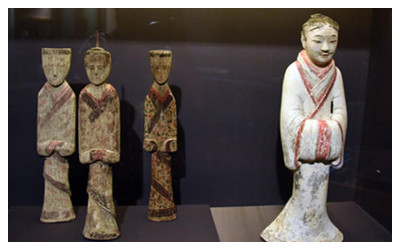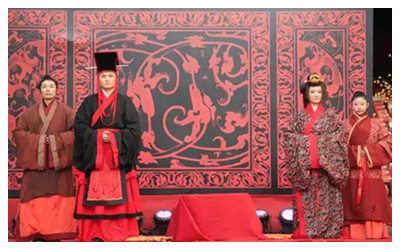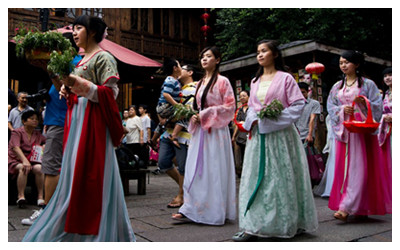Skype: neodalle-travel
Tel: +86 135 7447 2266
E-mail: sales@visitaroundchina.com

 From the reign of the Yellow Emperor (2696 BC-2598BC) to the end of the Ming Dynasty (1368 - 1644), Hanfu dominated the Chinese fashion world, a period of well over four thousand years.
From the reign of the Yellow Emperor (2696 BC-2598BC) to the end of the Ming Dynasty (1368 - 1644), Hanfu dominated the Chinese fashion world, a period of well over four thousand years.
The basic Hanfu form took shape during Xia (21th BC - 16th Century BC), Shang (17th - 11th Century BC) and Zhou Dynasties (11th Century BC - 256 BC). It has an upper coat and a dress from the waist down. This basic form did not alter, except for adding some embellishment. Clothing with no buttons and robes became fashionable in the Warring States Period (before 476 BC).
Later in Qin (221 - 206 BC) and Han (202 BC - 220AD) Dynasties, the robe’s design cutting changed to having two different hems, curved gem and straight hem. Only women’s clothing changed a little during Wei, Jin, Southern and Northern Dynasties (220 - 589). The upper portion of clothing for women became tighter, while the dress got to be longer and looser.
 n the Tang Dynasty (618 - 907), men favored a small black kerchief to cover the hair, while women liked high waist dress. Men wore cross collar or round collar clothing and women wore front opening dresses. After Tang Dynasty, Hanfu adapted some characteristics from the ethnic costumes. On military uniforms, buttons appeared later.
n the Tang Dynasty (618 - 907), men favored a small black kerchief to cover the hair, while women liked high waist dress. Men wore cross collar or round collar clothing and women wore front opening dresses. After Tang Dynasty, Hanfu adapted some characteristics from the ethnic costumes. On military uniforms, buttons appeared later.
During the Qing Dynasty (1644 - 1911), the Manchu regime banned Traditional Han Chinese Clothing. After the Qing, Chinese people had adopted western style clothes and the traditional Han people’s clothes never returned in force.
 A whole set of the Han Chinese Garment has three layers: an underwear, an inner garment and an overcoat. The three layers embrace ten elements: collar, hem, sleeve, lapel, belt and so on. And accessories such as socks, shawl and jade belt are used on the Hanfu.
A whole set of the Han Chinese Garment has three layers: an underwear, an inner garment and an overcoat. The three layers embrace ten elements: collar, hem, sleeve, lapel, belt and so on. And accessories such as socks, shawl and jade belt are used on the Hanfu.Hanfu is fashionable today
In recent years, there has been a revival of traditional Chinese attires. Some young people engaged in promoting Hanfu through the Internet social networking. On traditional Chinese festivals such as Tomb Sweeping Day and Mid-autumn Festival and formal occasions, the younger people put on their Hanfu. Once, on top of Xi'an City Wall, more than one hundred couples got married in a ceremony according to ancient edicts wearing Han Chinese garb.
 Ask Questions ?
Ask Questions ?